|
I'm
going to start this page off with a drill or an exercise
if you will. Throughout my years of teaching experience,
I've found that every student eventually hits a wall in
the development of their technique...
LEFT
AND RIGHT HAND COMMUNICATION.
Seems
simple enough. After all, that's what guitar playing's all
about physically. BUT, if your hands and fingers aren't
communicating properly, all those nifty bits you're trying
to play are gonna sound sloppy.
First,
we have to figure out exactly where the problems are. How
can we fix something we don't know is broken? We need to
pinpoint the trouble spots and that's where this little
exercise comes in handy.
Start
with your first finger on the 3rd string at the 5th fret,
your second finger on the 6th fret, third finger on the
7th and little finger on the 8th so they're lined up nice
and neat in a straight line on one string.
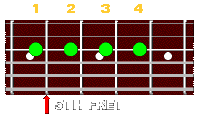
At
a moderate tempo, say 60 beats per minute, try picking eighth
notes one at a time starting from your first finger.
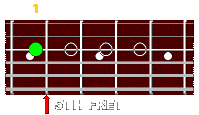
Gradually
increase your pick and finger speed evenly while trying
to keep each note clear and defined. Here's eighths at about
120 bpm (depending on your browser).
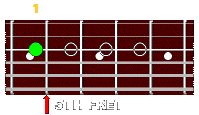
As
you go faster you'll probably reach a level at which you
lose control and that's the magic point right there!
There's your wall. Now let's figure out precisely what went
wrong.
Is
there a problem with your picking?
Keep
your first finger on the starting fret and without changing
the note, get your pick hand to duplicate the speed at which
the exercise fell apart. You should be able to pick in pulses
of four, smoothly and with definition. If this is a problem,
well at least we've identified it and that's the point!
To help increase control, make sure your pick and thumb
are angled slightly downward towards the floor, otherwise
you're flatpicking and fighting the string. Pick more from
your wrist, instead of your elbow and locate the pick closer
to the bridge where the strings are more resilient. Once
again, try picking fluidly until you reach the tempo at
which things collapsed. If this seems to be working fine,
we'll move on.
Fingering!
This
tends to be the real trouble spot. Let's see if they're
doing what they should be doing.
Start
again with your first finger on the first note and with
one pick stroke, try to roll the rest of your fingers through
the notes as if you were using hammer-ons. Each note should
come out clearly and if not, once again we have the opportunity
to identify a problem. I'll even go so far as to bet the
trouble is with the notes under your third and fourth fingers!
This is a very common problem with fret hand articulation.
So, how do we fix it?
Concentrate
on getting that third finger down with enough force to match
the previous notes. Get some good extension on your little
finger so it rides the edge of the 8th fret. In fact, it's
generally a good idea to keep all your fingers close to
the frets because this produces the maximum amount of sound
with the least bit of effort.
Remember,
control is the key. Now try this rolling effect again, starting
out slowly, gradually increasing speed until you reach the
original rate at which you crashed.
Once
you reach that point, it's time to get both hands working
together.
This
is where East meets West, each pick stroke has to instantly
react with a fretted note. So essentially the name of the
game is co-ordination.
With
this exercise, you should see a marked improvement in your
overall technique and if you don't, don't worry about it.
These things take time. See if you can keep up with the
animation. (Unfortunately, different browsers produce different
speeds so I couldn't clock it accurately - sorry about that).
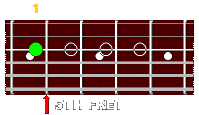
Once
you gain confidence with this drill, try playing it in reverse
leading with your little finger. The mechanics are essentially
the same except you use a series of rolling pull-offs.

Now
try forwards and backwards.

And
how about a little twist.
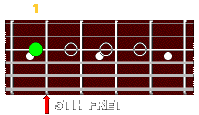
I
have to say I hit that same wall years ago. I was totally
frustrated so I went about trying to get around it, not
through it. I reasoned I should first detect where the problems
were so I could fix them. That's where this exercise came
in useful. It's one of the best tools I know of for determining
a weakness in your basic technique.
My
last comment is on mental attitude. I found from my own
experience, the drill was all well and good but I still
couldn't get over that last hurdle. Then I told myself to
relax. Finally!, everything worked. I had the control
and dexterity I'd been striving for. I hope the same works
for you.
|

